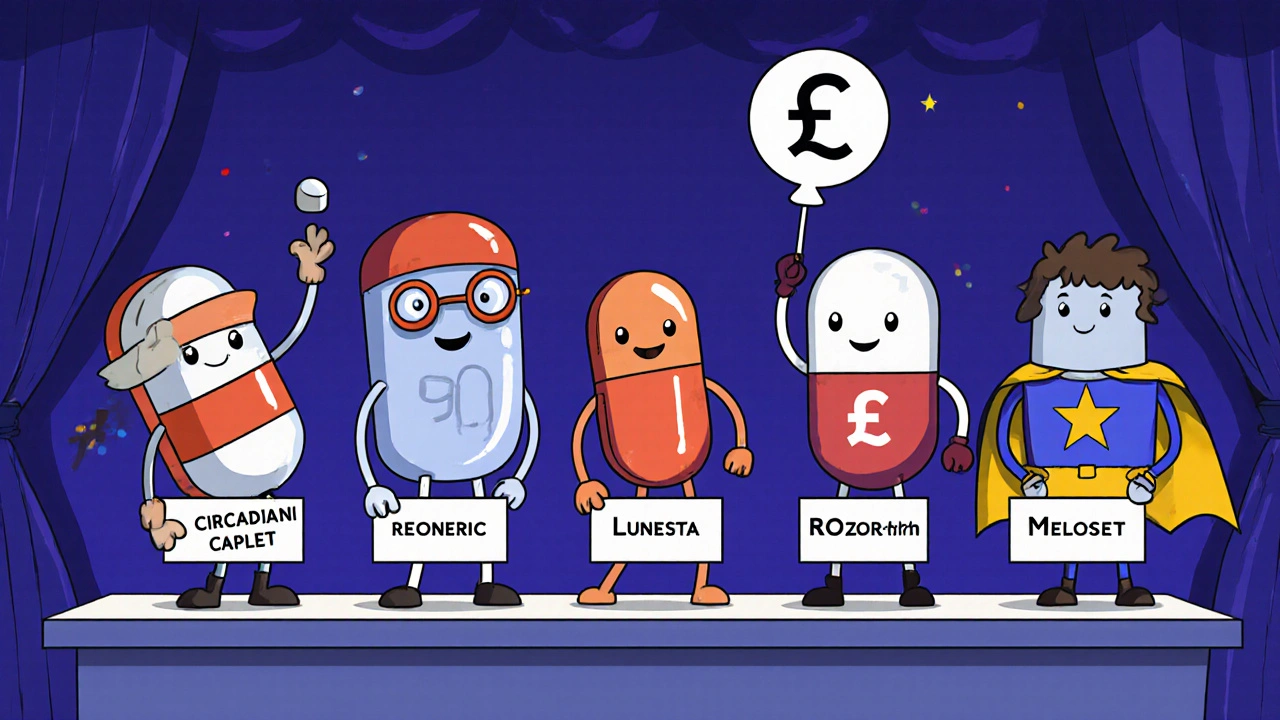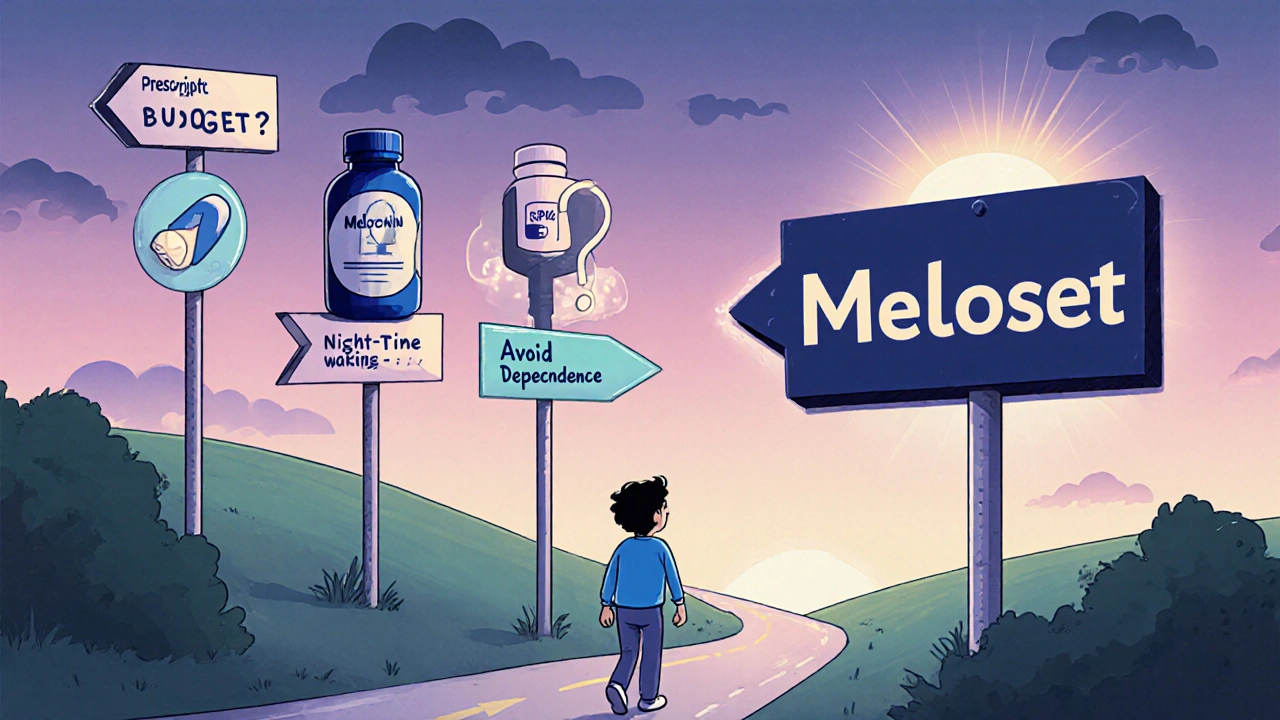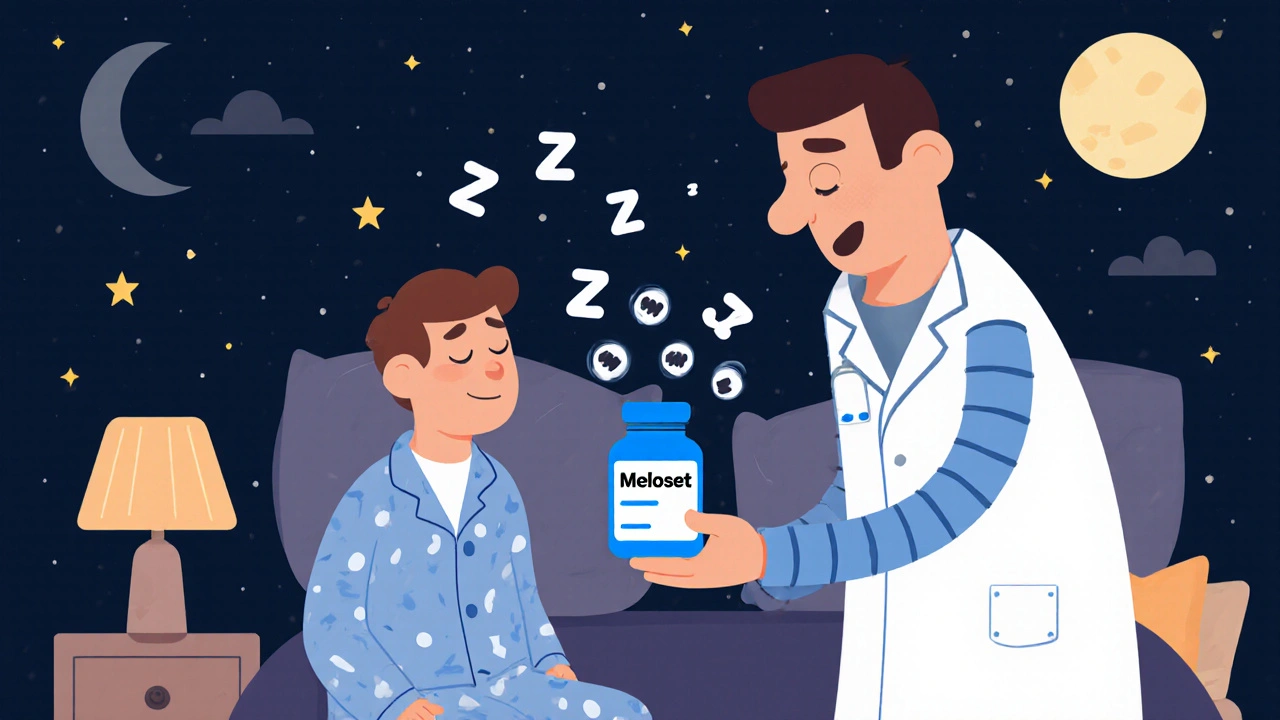Key Takeaways
- Meloset is a prescription‑only, timed‑release melatonin designed for long‑term sleep regulation.
- Over‑the‑counter brands like Natrol and generic 5 mg tablets are cheaper but release melatonin quickly.
- Prescription sleep drugs such as Lunesta and Rozerem work differently and carry higher side‑effect risks.
- Choose based on dosage form, price, how quickly you need sleep, and whether you prefer a prescription or OTC product.
What is Meloset?
Meloset is a prescription‑only, extended‑release melatonin product approved in the UK for adults with chronic insomnia. It comes in 2 mg tablets that release melatonin gradually over 8‑10 hours, mimicking the body’s natural night‑time surge. Because it’s regulated, you’ll need a GP’s prescription, but the controlled release can help people who wake up repeatedly during the night.
How melatonin works
Melatonin itself is a hormone produced by the Suprachiasmatic nucleusthe brain's master clock located in the hypothalamus. As daylight fades, the nucleus signals the pineal gland to release melatonin, signaling the body that it’s time to sleep. This hormone helps align the sleep‑wake cyclethe 24‑hour rhythm that governs alertness and rest. Low melatonin levels can lead to insomniadifficulty falling or staying asleep, especially in older adults whose natural production declines.
Melatonin is synthesized from serotonina neurotransmitter that regulates mood and sleep. When you take a supplement, you boost that signal, telling the brain that night has arrived. The speed and duration of the signal depend on the formulation-immediate‑release versus extended‑release.

Top melatonin alternatives
Below are the most common alternatives you’ll see on pharmacy shelves or in a GP’s office.
- Natrol Melatoninan over‑the‑counter brand offering 1 mg, 3 mg, and 5 mg immediate‑release tablets. It’s cheap, widely available, and works best for people who fall asleep quickly but may wake up after a few hours.
- Circadina 2 mg prolonged‑release melatonin tablet approved in the EU for patients over 55 with insomnia. Similar to Meloset but sold OTC in some countries, making it easier to obtain.
- Generic 5 mg melatoninunbranded tablets that release the hormone immediately. The most affordable option, but the rapid spike can cause morning grogginess for some users.
Prescription sleep‑aid drugs work differently and are generally reserved for more severe cases.
- Lunestaa non‑benzodiazepine hypnotic (eszopiclone) prescribed for short‑term insomnia. Provides fast onset but can cause dependence and next‑day drowsiness.
- Rozerema melatonin‑receptor agonist (ramelteon) that mimics natural melatonin without the hormone itself. Only prescription‑only, good for sleep‑onset problems, with minimal dependence risk.
Comparison table
| Product | Formulation | Strength | Prescription? | Typical price (UK) | Best use case |
|---|---|---|---|---|---|
| Meloset | Extended‑release tablet | 2 mg | Yes | £12‑£18 for 28 tablets | Long‑lasting sleep maintenance |
| Natrol Melatonin | Immediate‑release tablet | 1‑5 mg | No | £4‑£8 for 60 tablets | Quick sleep onset, occasional use |
| Circadin | Prolonged‑release tablet | 2 mg | No (OTC in EU) | £7‑£12 for 30 tablets | Older adults, chronic insomnia |
| Generic melatonin | Immediate‑release tablet | 5 mg | No | £3‑£5 for 100 tablets | Budget-friendly, occasional |
| Lunesta (eszopiclone) | Oral capsule | 1‑3 mg | Yes | £15‑£25 for 28 capsules | Severe short‑term insomnia |
| Rozerem (ramelteon) | Oral tablet | 8 mg | Yes | £30‑£45 for 30 tablets | Sleep‑onset difficulty, low dependence risk |

Choosing the right option
Here’s a quick decision guide you can follow:
- Do you need a prescription? If you prefer buying at a pharmacy without a GP visit, stick with Natrol, Circadin, or generic melatonin.
- Is night‑time waking a problem? Meloset’s extended‑release profile is built for staying asleep, whereas immediate‑release brands may leave you tossing.
- What’s your budget? Generic 5 mg melatonin is the cheapest, but you might spend a bit more for the smoother release of Meloset or Circadin.
- Are you looking for a short‑term fix? Prescription hypnotics like Lunesta act fast but should only be used for a few weeks.
- Do you want to avoid dependence? Melatonin (any form) and Rozerem carry minimal risk, while Lunesta can lead to tolerance.
Most people start with an OTC product, see how their body reacts, and then talk to a doctor if they need longer coverage. If you already have a prescription, Meloset offers the most consistent night‑time hormone level.
Frequently Asked Questions
Can I take Meloset without a prescription?
No. In the UK, Meloset is classified as a prescription‑only medicine, so you’ll need a GP’s approval before you can buy it.
How does extended‑release melatonin differ from immediate‑release?
Extended‑release (like Meloset or Circadin) spreads melatonin into the bloodstream over several hours, helping you stay asleep. Immediate‑release spikes quickly, which can get you to bed faster but may wear off before sunrise.
Are there any safety concerns with melatonin supplements?
Melatonin is generally safe for short‑term use. High doses can cause daytime drowsiness, vivid dreams, or mild gastrointestinal upset. People on blood‑thinners or anti‑seizure meds should check with a doctor.
When should I consider CBT‑I instead of a supplement?
Cognitive‑behavioural therapy for insomnia (CBT‑I) is the first‑line treatment for chronic insomnia. It addresses underlying thoughts and habits, offering lasting improvement without medication.
Can I mix melatonin with prescription sleep aids?
Mixing melatonin with drugs like Lunesta can increase sedation and should only be done under medical supervision. Always discuss any combination with your GP.
 Oct, 26 2025
Oct, 26 2025

naoki doe
October 26, 2025 AT 22:00Extended‑release melatonin like Meloset spreads the hormone over the night, which can cut down those middle‑of‑the‑night awakenings.
Because the dose is only 2 mg, it mimics the body’s natural output more closely than a 5 mg immediate‑release hit.
People who tend to get up after a few hours often report feeling more refreshed after switching.
The prescription requirement means a doctor can check for interactions, which is a safety plus.
It’s pricier than over‑the‑counter options, but the steady release may justify the cost for chronic insomniacs.
In the UK the drug is regulated, so you know you’re getting a consistent formulation.
If you’re already on a low dose of melatonin, you might not need to jump straight to a hypnotic.
Overall, the trade‑off is between convenience and the smoother sleep curve.
Carolyn Cameron
October 29, 2025 AT 05:33In the realm of somnolence therapeutics, Meloset occupies a niche distinguished by its pharmacokinetic profile, delivering melatonin in a controlled manner over the course of eight to ten hours. The prescription‑only status ensures that clinicians can supervise its integration into a patient’s regimen, thereby mitigating potential drug‑drug interactions. Comparative analyses reveal that immediate‑release preparations, such as those offered by Natrol, precipitate a rapid surge in plasma melatonin, which may facilitate sleep onset but fails to sustain nocturnal sleep continuity. Conversely, the extended‑release matrix of Meloset aligns more congruently with the endogenous melatonin rhythm, rendering it advantageous for individuals afflicted with fragmented sleep architecture. Economic considerations remain salient; whilst the cost exceeds that of generic counterparts, the therapeutic yield may offset the expenditure for chronic sufferers. Thus, clinicians ought to evaluate both the pharmacodynamic demands and the fiscal implications prior to endorsement.
Katherine Brown
October 31, 2025 AT 13:06When deciding between extended‑release and immediate‑release melatonin, it helps to reflect on your personal sleep pattern. If you frequently awaken after a few hours, a product like Meloset or Circadin could provide the steady hormone release you need. On the other hand, if you simply struggle to fall asleep initially, an over‑the‑counter 1‑mg tablet might be sufficient. Pricing is also a factor; generics are budget‑friendly, whereas prescription options carry a higher price tag but come with medical oversight. Many users find it useful to start with a modest OTC dose, monitor how their body reacts, and then discuss with a healthcare professional if longer‑lasting support becomes necessary. Ultimately, the choice should harmonize with your health goals, financial comfort, and the guidance of your physician.
Leah Ackerson
November 2, 2025 AT 20:40One could argue that the elegance of a prescription‑only formulation is less about exclusivity and more about stewardship. 🌙 Yet, when a molecule is encased in a slow‑release polymer, we are merely outsourcing the body’s own circadian wisdom. The philosophical quandary emerges: do we trust our internal clock or the chemist’s design? In practice, the benefits of consistent night‑time melatonin levels often outweigh the allure of cheap, instant spikes. Still, the market dynamics that favor higher priced options can feel like an echo of elitist health paradigms. 🤔 Embracing both science and simplicity may lead to a more balanced nocturnal experience.
Stephen Lenzovich
November 5, 2025 AT 04:13From a patriotic standpoint, it’s worth noting that American manufacturers produce a range of melatonin supplements that are both affordable and rigorously tested. While Meloset is a British prescription product, the underlying principle of extended‑release can be found in domestic formulations marketed under different brand names. Consumers who prefer to keep their health care dollars within the national economy might opt for those alternatives. Still, the regulatory oversight in the UK ensures a standard of quality that some might find reassuring. Price, however, is not the sole metric; the convenience of pharmacy access without a doctor’s note can be a decisive factor for many. Ultimately, the decision rests on a balance between national loyalty, cost‑effectiveness, and the desire for a consistent sleep pattern.
abidemi adekitan
November 7, 2025 AT 11:46Let’s walk through the landscape of melatonin options as if we were exploring a vibrant marketplace, each stall offering its own flavor of nocturnal aid. First, imagine Meloset as the artisan baker’s loaf: carefully crafted, measured, and meant to nourish you over the entire night, not just a fleeting bite. Its extended‑release mechanism releases melatonin gradually, mimicking the gentle tide of your own pineal rhythm, which can be a blessing for those who find themselves tossing and turning as the moon climbs higher. Next, picture the generic over‑the‑counter tablets as the street vendor’s quick‑serve snack-cheap, fast, and effective for a short burst of sleep onset, yet they often fade before sunrise, leaving you drowsy at dawn. Natrol’s line, for instance, offers a spectrum of dosages, letting you tailor the intensity to your personal tolerance, but it lacks the sustained release that keeps you nestled in a deep slumber. Circadin, meanwhile, occupies a middle ground: a prolonged‑release tablet available without a prescription in many European locales, offering a cost‑effective compromise for the older adult seeking stability without the bureaucracy of a GP visit.
Now, consider the prescription hypnotics such as Lunesta; they are like powerful fireworks-bright, immediate, and potentially habit‑forming, suitable only for short‑term rescue missions under medical supervision. Rozerem, on the other hand, is a more nuanced sparkler, targeting melatonin receptors directly without flooding the system with the hormone itself, thus reducing dependence risks while still aiding sleep onset.
When you evaluate these choices, think of your sleep goals as a tapestry: do you need a gentle, continuous glow, or a bright flash that nudges you into dreamland? Your budget, health status, and willingness to engage with a healthcare professional will weave together the final picture. Remember, melatonin is generally safe for short‑term use, but high doses can invite side‑effects like vivid dreams or morning grogginess, especially if you are on blood thinners or anti‑seizure medications.
Finally, never overlook the non‑pharmacological hero, CBT‑I; it reshapes the very habits that underlie insomnia, offering a lasting solution without any pill. In the end, whether you gravitate toward a prescription‑only gem like Meloset or a humble OTC tablet, the key is to listen to your body, stay informed, and seek professional advice when the night’s darkness feels too heavy.
Ramesh Kumar
November 9, 2025 AT 19:20Here’s a quick rundown: melatonin’s half‑life is short, so immediate‑release forms give you a spike that lasts maybe an hour or two, whereas extended‑release keeps the level elevated for most of the night. The 2 mg dose in Meloset is close to the amount your pineal gland would naturally produce, which is why many people tolerate it well. If you’re on blood thinners, even a modest melatonin supplement can affect clotting, so a chat with your doctor is wise. OTC options like Natrol are handy for occasional jet‑lag, but for chronic insomnia you might need the steady profile that a prescription product offers. Also, keep an eye on the label: some “natural” melatonin blends contain herbs like valerian or passionflower, which add their own effects. In short, choose the formulation that matches the part of the night you struggle with-falling asleep or staying asleep.
Barbara Ventura
November 12, 2025 AT 02:53Sticky mornings often disappear with a proper extended‑release melatonin.